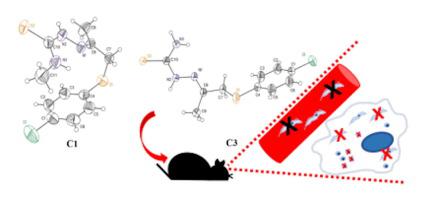Bioorganic Chemistry ( IF 4.5 ) Pub Date : 2021-05-25 , DOI: 10.1016/j.bioorg.2021.105018 Diego Rodney Rodrigues de Assis 1 , Alexandre Almeida Oliveira 2 , Samuel Luiz Porto 1 , Rayane Aparecida Nonato Rabelo 1 , Eduardo Burgarelli Lages 3 , Viviane Corrêa Santos 1 , Matheus Marques Milagre 4 , Stenio Perdigão Fragoso 5 , Mauro Martins Teixeira 1 , Rafaela Salgado Ferreira 1 , Carlos Renato Machado 1 , Lucas Antônio Miranda Ferreira 3 , Nivaldo Lucio Speziali 6 , Heloisa Beraldo 2 , Fabiana Simão Machado 7

|
Chagas disease (ChD), caused by Trypanosoma cruzi, remains a challenge for the medical and scientific fields due to the inefficiency of the therapeutic approaches available for its treatment. Thiosemicarbazones and hydrazones present a wide spectrum of bioactivities and are considered a platform for the design of new anti-T. cruzi drug candidates. Herein, the potential antichagasic activities of [(E)-2-(1-(4-chlorophenylthio)propan-2-ylidene)-hydrazinecarbothioamides] (C1, C3), [(E)-N'-(1-((4-chlorophenyl)thio)propan-2-ylidene)benzohydrazide] (C2), [(E)-2-(1-(4-, and [(E)-2-(1-((4-chlorophenyl)thio)propan-2-ylidene)hydrazinecarboxamide] (C4) were investigated. Macrophages (MOs) from C57Bl/6 mice stimulated with C1 and C3, but not with C2 and C4, reduced amastigote replication and trypomastigote release, independent of nitric oxide (NO) and reactive oxygen species production and indoleamine 2,3-dioxygenase activity. C3, but not C1, reduced parasite uptake by MOs and potentiated TNF production. In cardiomyocytes, C3 reduced trypomastigote release independently of NO, TNF, and IL-6 production. C1 and C3 were non-toxic to the host cells. A reduction of parasite release was found during infection of MOs with trypomastigotes pre-incubated with C1 or C3 and MOs pre-stimulated with compounds before infection. Moreover, C1 and C3 acted directly on trypomastigotes, killing them faster than Benznidazole, and inhibited T. cruzi proliferation at various stages of its intracellular cycle. Mechanistically, C1 and C3 inhibit parasite duplication, and this process cannot be reversed by inhibiting the DNA damage response. In vivo, C1 and C3 attenuated parasitemia in T. cruzi-infected mice. Moreover, C3 loaded in a lipid nanocarrier system (nanoemulsion) maintained anti-T. cruzi activity in vivo. Collectively, these data suggest that C1 and C3 are candidates for the treatment of ChD and present activity in both the host and parasite cells.
中文翻译:

4-氯苯硫代丙酮衍生的缩氨基硫脲作为有效的抗锥虫候选药物:作用方式的研究
由克氏锥虫引起的恰加斯病 (ChD)仍然是医学和科学领域面临的挑战,因为可用于其治疗的治疗方法效率低下。硫缩酮和腙具有广泛的生物活性,被认为是设计新的抗克氏锥虫候选药物的平台。在此,[( E )-2-(1-(4-氯苯硫基)丙-2-亚基)-肼碳硫酰胺] ( C1, C3 ), [( E )-N'-(1-(( 4-氯苯基)硫代)丙-2-亚基)苯甲酰肼](C2),[(E)-2-(1-(4-,和[(E))-2-(1-((4-氯苯基)硫代)丙-2-亚基)肼甲酰胺]( C4 )进行了研究。来自 C57Bl/6 小鼠的巨噬细胞 (MO) 用C1和C3但不是用C2和C4刺激,减少了无鞭毛体复制和锥鞭毛体释放,独立于一氧化氮 (NO) 和活性氧物质的产生以及吲哚胺 2,3-双加氧酶活性。C3,但不是C1,减少了 MO 对寄生虫的吸收并增强了 TNF 的产生。在心肌细胞中,C3减少了锥鞭毛体的释放,与 NO、TNF 和 IL-6 的产生无关。C1和C3对宿主细胞无毒。在用C1或C3预孵育的锥鞭毛体和感染前用化合物预刺激的 MO 感染 MO 期间发现寄生虫释放减少。此外,C1和C3直接作用于锥鞭毛体,杀死它们的速度比苄硝唑更快,并在细胞内循环的各个阶段抑制了克氏锥虫的增殖。从机制上讲,C1和C3抑制寄生虫复制,并且无法通过抑制 DNA 损伤反应来逆转这一过程。在体内,C1和C3减弱了T. cruzi的寄生虫血症- 感染小鼠。此外,装载在脂质纳米载体系统(纳米乳剂)中的C3在体内保持抗克氏锥虫活性。总的来说,这些数据表明C1和C3是治疗 ChD 的候选物,并且在宿主和寄生虫细胞中都有活性。















































 京公网安备 11010802027423号
京公网安备 11010802027423号